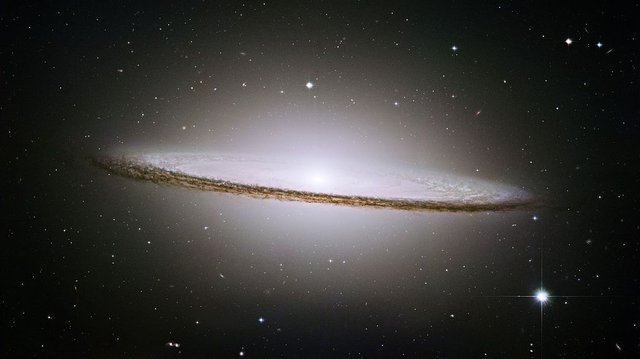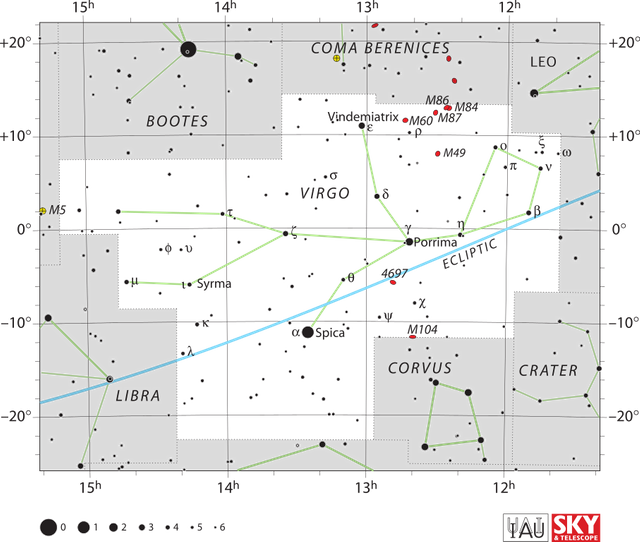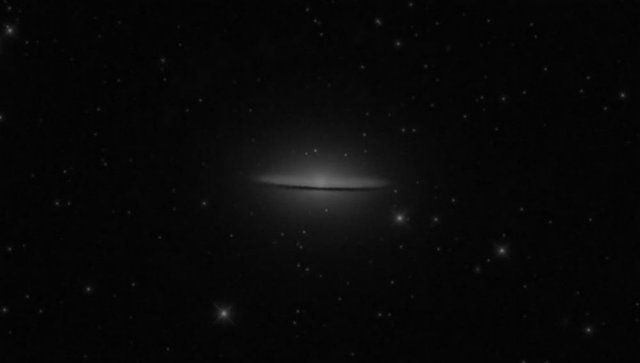In this episode we will look at a quite specific galaxy - M104 is a spiral galaxy located in the southern part of the Virgo constellation. The name suits its appearance, reminiscent of a wide Mexican hat. The facility is within the reach of astro amateurs with larger telescopes.

By NASA/ESA and The Hubble Heritage Team (STScI/AURA) link [Public domain]
Discovered in 1781, the galaxy entered the Messier catalog only in 1921. This object lies on the border between the constellations of the Virgo and the Corvus, in the southern part of the sky. M104 brightness observed from Earth is close to +9 magnitude, so you can find it only with large 15 X 70 binoculars under a good dark sky. This object isn't visible to the naked eye. The angular dimensions of the object are 8.7 × 3.5 arc minutes, i.e. it is quite a small object, which in binoculars will only be a thin, misty spot. Unfortunately, the hunt for a galaxy requires a telescope, preferably a large and dark sky, away from major cities.

By IAU and Sky & Telescope magazine (Roger Sinnott & Rick Fienberg) link [CC BY 3.0 license]
Using an 8-inch telescope in perfect conditions will allow you to see the dark band of the Sombrero Galaxy. However, a 12-inch telescope during a moonless night away from the light of cities (in Poland, preferably in the Bieszczady mountains) will show a similar view to that in the photo below, showing the appearance of the M104 known to us from the photos. In a 12-inch instrument, the dark band is obvious to anyone who looks at the eyepiece, in smaller telescopes it may be harder to see them. In even larger instruments we will see the view almost like in the pictures with a long exposure time. The diameter of the telescope is crucial because it affects the amount of light collected and the brightness of the observed object.

(My modification) Original by Carsten Frenzl from Obernburg, Deutschland link [CC BY 2.0 license]
The Sombrero Galaxy has a large and bright nucleus, has weakly developed spiral arms and has a strip of non-luminous matter built mainly of dust. This ring has a diameter of about 60,000 light years. The galaxy contains many globular clusters that form a spherical halo (light glow) around it. Messier 104 galaxy is about 30 million light years away from us. Inside the M104 nucleus is probably a huge black hole that drives the disk spinning around the core of the galaxy.


COMO SE LLAMARA PARA OTRAS CIVILIZACIONES?....
Downvoting a post can decrease pending rewards and make it less visible. Common reasons:
Submit
This story was recommended by Steeve to its users and upvoted by one or more of them.
Check @steeveapp to learn more about Steeve, an AI-powered Steem interface.
Downvoting a post can decrease pending rewards and make it less visible. Common reasons:
Submit
This post has been voted on by the SteemSTEM curation team and voting trail in collaboration with @curie.
If you appreciate the work we are doing then consider voting both projects for witness by selecting stem.witness and curie!
For additional information please join us on the SteemSTEM discord and to get to know the rest of the community!
Downvoting a post can decrease pending rewards and make it less visible. Common reasons:
Submit
es PRECIOSO...
Downvoting a post can decrease pending rewards and make it less visible. Common reasons:
Submit
Congratulations @astromaniac! You have completed the following achievement on the Steem blockchain and have been rewarded with new badge(s) :
Click here to view your Board
If you no longer want to receive notifications, reply to this comment with the word
STOPDownvoting a post can decrease pending rewards and make it less visible. Common reasons:
Submit
Increíble trabajo!
Downvoting a post can decrease pending rewards and make it less visible. Common reasons:
Submit